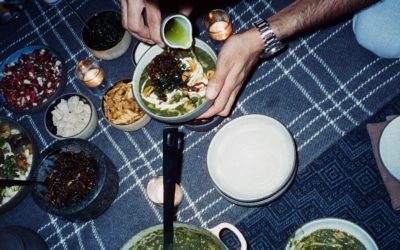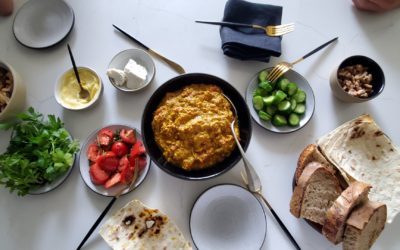My mother and I didn’t always get along. To be entirely honest, we had a hard relationship growing up. I couldn’t understand why she was so incredibly strict. Why she had these habits that no one could call her out on. She was and still is without question, the strongest person I know; in personality and in so much more. My brother and I learned pretty early on growing up, that you couldn’t defy her. If she made a case to have things her way, that’s how it was going to be, no questions asked. We had to respect that. Her passion for certain things had to come from somewhere, and it didn’t matter if we did not always see that.
I got to spend time in the kitchen with my mom a few days ago. One of the perks of being technically jobless and locked away in the home. She was showing me her way of making one of my favourite childhood foods called “kobeh”. It is essentially a jasmine rice dumpling that has been scented with saffron and stuffed with a mixture of ground beef and lamb which is seasoned with aromatic and sultry spices. It’s slowly shallow-fried until the outside of the rice is perfectly crispy and the center of the dumpling is at the point of melting. “Kobeh” is a cross between the Lebanese Kibbeh (which is based in fine bulgur) and the Persian Tadig (which is the crispy wafer at the bottom of the rice pot). My mom is originally from a part of Iran called “Mohamareh” or more currently known as “Khuzistan”. This provence, as like many others, share one of Iran’s 7 land borders with their surrounding neighbouring countries. Through this proxy, there are recipes specific to Khuzistan that do not appears elsewhere in Iran. Specific hybrid foods that have passed through years of cultural collaboration and influence. Taking a single part of each regions ethnic identity and creating something truly incredible out of it. It is very much the same as a region such as Alsace whose cuisine is the unified spirit of both French and German culture.
This form of exchange occurs all throughout Iran. I think more than any country in the world, our previous, pre-islamic curiosity when it concerned other cultures was not so much about the social or racial politics of the place, but rather than what they were cooking. We didn’t care about your religion, or your language, as long as you promised to add something delicious to the table. Iran embodied this spirit and this value for much of history. And as circumstances are as they are, and this free thought is allusive now in most countries in our modern day at best. I think that these recipes, the ones that represent the collaborations between countries, the unifying natures of food; they are the most precious, and within our duty as cooks to both celebrate and protect.
A Few Things Before You’re On Your Way
– No Shortcuts With Rice. This recipe is super simple, there are only a handful of components but they need to be perfect. Don’t substitute the rice for anything. Basmati won’t work. Day old rice won’t work. Cold rice won’t work. The hardest part of the process is forming the dumplings, things need to be perfect in order to make the process painless.
– Create With Confidence. Be confident when spicing your meat mixture, get creative with it. Every middle eastern family has their variations on traditional recipes. Get creative with how you use nuts, seeds, dried fruit and more to stuff the dumplings. Be curious about your spices, be heavy handed on certain things you like such as cinnamon or allspice. If it taste delicious, there is nothing wrong with it.
– Take Your Time. Don’t rush the forming of the dumplings. Be patient when you’re frying it. Every step is critical in order to pull of something truly spectacular.
Ingredients:
For The Rice:
– 550g Jasmine Rice, unwashed
– 1060g Cold Water
– 2g Saffron, ground fine
– Salt to taste
For The Filling:
– 225g Ground Beef
– 225g Ground Lamb
– 150g Yellow Onion, small diced
– 30g Garlic, minced
– 150g Split Yellow Lentils
– 30g Olive Oil
– 20g Tomato Paste
– 10g Advieh or Baharat
– 5g Turmeric
– 2g Cinnamon, ground
– 50g Slivered Almonds
– 20g Parsley, finely chopped
– Salt & Black Pepper to taste
– Add other filling ingredients and spices if inclined
Other:
– 1L neutral oil such as vegetable or canola (for shallow frying the dumplings)
– 4 Eggs, beaten (to egg wash the dumplings)
Garnish:
– Your favourite hot sauce or
– Pickled Relish
– Fresh Limes
Process:
For The Rice:
– In a heavy based pot, add your rice, saffron, water and season with salt to taste. You want the rice to be well seasoned as it makes up the majority of the dumpling.
– Place over high heat and bring up to a simmer. Reduce the heat to low and cover with a tight fitting lid. Cook for 50 minutes until soft and sticky but where the rice grains are still in tact.
– Scoop the rice out of the pot, and transfer to a bowl. Cover with a towel and let rest for 1 hour. Discard the baked on film at the bottom of the pot as it doesn’t make good dumpling dough.
For The Filling:
– Place split yellow lentils into a small pot with 2 cups of water. Over medium-high heat, bring to a simmer. Season with salt and pepper to taste. Reduce the heat to low and allow to simmer for 10-15 minutes until tender. Strain the excess water and set aside.
– Meanwhile, add olive oil to a wide pan over medium heat. Add onions and garlic. Cook for 5 minutes until soft and fragrant.
– Turn the heat up to high and add ground beef and lamb. Brown the meat for 5-6 minutes. Using the back of a wooden spoon, break up the clusters of ground meat. Reduce the heat to medium-low, add tomato paste and cook to caramelize the tomato paste for 3-4 minutes.
– Add your strained tender yellow split lentils, advieh (or baharat), turmeric, cinnamon, slivered almonds & parsley. Cook until the mix is fragrant, approximately 2 minutes. Season liberally with salt and pepper.
– Transfer the mixture to a bowl and allow to cool for 30 minutes.
For The Dumplings:
– Set up a station with a small bowl of water, a bowl of egg wash, a sheet trays brushed with oil, your bowl of cooked rice, and your bowl of ground meat filling with a tablespoon.
– To make the dumplings, start by coating your hands gently in water. Grab a mound of rice the size of a small orange in your hand. Mash up the rice in your one hand gently by pressing your fingers to the palm of your hand to create a mealy rice doug. Cover your other hand again lightly with water, and transfer the dough onto your other wet hand (you will notice how sticky your first hand is from handling the rice).
– Rewet your first hand lightly, and using the tips of your finger, spread out the dough in you second hand into a flat even circle approximately a 1/2 of an inch thick. Take a heaping tablespoon of your filling and place it into the center of the rice dough and gentle press it down with the back of your spoon. Using your palm, grip the dough together as if you are holding a baseball to help bring all the sides together. Using your free hand, pinch the top of the dumpling closed, assuring that rice is tightly wrapping the filling.
– Carefully press the dumpling back and forth between your two hands to assure that the dumpling is tight and evenly closed as possible. Form the dumpling into the shape of a round puck.
– Be careful as to how much and often you soak your hands with water as it will wash away the starch on the rice and it will make it difficult to shape and close. The rice needs to remain very sicky to form the dumplings. Place the finish dumpling on a sheet tray brushed with oil.
– Repeat this process for all the dumplings until you are out of rice. Reserve any ground meat to make either a second batch of dumplings or for other recipes such as dolmehs.
– Once all the dumplings are finished, dip your fingers lightly into egg wash and liberally cover the outside of each of the rice dumplings. Allow the dumplings to set up for 30 minutes at room temperature.
– Meanwhile, in a wide shallow pan, place enough oil to shallow fry the dumplings (the oil should come up halfway on the dumplings once you fill the entire pan, so adjust once your first round of dumplings are frying). Place over medium heat and bring up to 325°F.
– Reduce your heat to medium-low. Place your dumplings carefully into the pan and allow to fry until the one side is golden and crispy. The time it takes for this process depends on various things such as the doneness of your rice, the quality of the rice, the amount of water you used to form the dumpling, ect. Watch your dumplings carefully after 5 minutes to flip them when they’re golden.
– Flip the dumpling over when ready and repeat the process again until both sides are crispy and colored. The dumpling is also dehydrating in the oil and becoming more dense. A loosely made dumpling will also absorb a ton of oil so shaping and egg washing the dumpling is critical in our previous step.
– Remove the dumplings when done and place it on a tray lined with paper towel to blot the excess oil. Allow them to cool for 10 minutes before serving.







